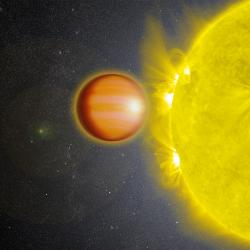Astronomy Visiting Assistant Research Scientist Ronald Gamble Answers Questions About Black Holes
The College of Computer, Mathematical, and Natural Sciences hosted a Reddit Ask-Me-Anything spotlighting astrophysics research.
University of Maryland Astronomy Visiting Assistant Research Scientist Ronald Gamble participated in an Ask-Me-Anything (AMA) user-led discussion on Reddit to answer questions about black holes on February 25, 2025.
Gamble is a theoretical astrophysicist at NASA Goddard Space Flight Center researching the energy emission processes of relativistic jets from high-energy active galactic nuclei and their connection to Supermassive Black Hole rotations. He is a CRESST-II Visiting Assistant Research Scientist at NASA Goddard Space Flight Center and the University of Maryland, College Park. He also has seven years of experience in academia as a physics, mathematics and computational science instructor and curriculum developer.
This Reddit AMA has been edited for length and clarity.

Are black holes a somewhat slim disk, or do they take the form of a sphere? Is there a difference when looking at a black hole from the side or the back?
The geometry of black holes is called an oblate spheroid; you can think of that shape as a fat football. There is equatorial symmetry, meaning that if you are in the front and you walk toward the back, it is unchanged. If you are at the pole and you walk down toward the equator, that is not symmetrical. The disc you see is light bent from the back of the black hole toward the front.
Everyone knows black holes have super strong gravity, but do they also have extremely intense electromagnetic fields? If so, what kind of effects does that have on nearby objects or particles?
The strength of electromagnetic fields around black holes depends on the density of matter around the black hole. If you have a lot of plasma, you're going to have a strong magnetic field. Other compact objects that have the strongest magnetic fields in the universe are called pulsars and magnetars.
How did you get into grad school? What would you recommend for people currently graduating undergrad in astrophysics?
Storytime! I studied high-temperature superconducting thin films for my master's degree in condensed matter physics while also learning the mathematics I would eventually need for my Ph.D. work in gravitational wave theory. I graduated from North Carolina A&T State University in undergrad and also stayed there for grad school. I persistently studied a lot of subjects outside of my coursework that I knew I would need for the research I wanted to do after grad school.
I would recommend you get better at coding, learn all the mathematics that you can (specifically vector calculus) and learn how to combine both of those in the context of physics. The other thing I would recommend is that you go back to your fundamental courses and re-describe those concepts that you learned using only words, not mathematics. That's how you build a more intimate understanding of astrophysics.
What is the largest discrepancy in perception of time that we are aware of being possible between someone next to the largest known black hole and someone a safe distance away (on Earth maybe)?
There are many factors when calculating the perception of time near a black hole versus being on Earth. This is called gravitational time dilation, and you can calculate this yourself actually. You can look up the mass of the black hole called Phoenix A, which has a mass of about 10^10 solar masses, and use the distance between Earth and Phoenix A, and calculate time near Earth and time near the black hole using time dilation. That'll give you the largest discrepancy in perception of time that we know of by using the largest black hole that we've found.
What do you think of Roger Penrose's theory that after heat death the universe only contains photons, and as photons don't experience time or space, the conditions are indistinguishable from those thought to have preceded the Big Bang?
Photons do experience time and space. Particle paths called geodesics describe the trajectory of photons as they travel through spacetime. Since photons are considered radiation, the universe is approximately made up of 4% radiation, while the other 96% consists of different types of matter (e.g., dark matter, dark energy, electrons, etc.).
How can a black hole emit a jet of particles if not even light can escape its gravity?
That's a very good question that my research (and others) aims to answer. We need more creativity in developing these theories about particle acceleration and jet-launching mechanisms.
The Big Bang Theory says that everything long ago was compressed in a single tiny spot, like a black hole. That spot exploded, though, to create the universe. Are there any ideas about how massive a black hole can get before it's simply too much energy to constrain, so it destabilizes and explodes into... something that's no longer a black hole?
Currently, we don't have a complete understanding of the growth of supermassive black holes, which is the upper limit on the mass scale of black holes. Much like the Big Bang Theory, in terms of cosmic inflation, there is another hypothesis that says that the universe is forever expanding, so this is physical cosmology. You can check out this NASA animation to get a better idea of the scale of black holes.
I’ve recently seen news about how massive these relativistic jets can be, 24 million light-years with Porfyrion if I remember correctly. Does this suggest that supermassive black holes are actively building the cosmic web? If they are, what do you think about the significance of this, and might the cosmic web itself have some sort of larger purpose in the universe that we haven't thought of before?
In a sense, yes. The jets from supermassive black holes are contributing to the circumgalactic medium when they are launched. We have not completely understood how jets can grow this large. The 24 million light-year jet from that radio galaxy you're referring to (Porfyrion) breaks the scale on what we know about jets.
I always wondered how powerful these jets are. Can they vaporize a planet? Or a spaceship? And if they can, at what distance from the black hole can they become safe to cross?
Short answer: You cannot cross a jet. The power of jets is on the scale of 10^40 ergs per second, which makes them some of the most powerful objects in the universe. So yes, they could vaporize a planet.
Relativistic jets are still one of the biggest puzzles in astrophysics. What are your thoughts on the role of magnetic fields in launching and collimating these jets? Do you lean more toward the Blandford-Znajek mechanism, or do you think other processes could be equally significant?
This is exactly what my research is on! The role magnetic fields play in launching these jets is pretty substantial. They certainly contribute to the collimation of relativistic jets both at short and long distances, and we see evidence of this in radio and X-ray observations. Regarding the Blandford-Znajek mechanism, there are some consistencies that we see with observations, but I also believe that the magnetic fields that are generated from the accretion discs are not the principal reason why jets are launched. We need more advanced theory that involves general relativity dynamically in describing particle acceleration. If you want to learn more about my research, you can read one of my papers here.
Is there any significant research/evidence of white holes? Are you aware of or involved in any studies that black holes are ejecting what they absorb out of a related white hole within our universe or another?
There is currently no observational evidence of white holes. A fun fact, though, is that if you look at the full mathematical solution of a black hole, according to a Penrose diagram, you will find that there is a white hole on the other side. This is what's considered a complete mathematical solution for matter going inside of a black hole, coming outside of a white hole and into an anti-verse. You can learn more about these Penrose diagrams and accompanying animations of black holes here.
How are elementary particles (electrons, positrons, etc.) accelerated to near the speed of light at the base of these jets?
A very short answer: we don't know yet. You can follow my research and learn more about it in this video and on my website.







